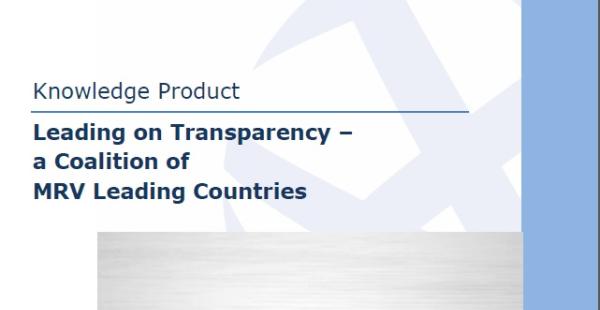
Promoting leadership on transparency in climate change policy
‘MRV’, ‘leadership’ and ‘groups/clubs/coalitions’ were the buzzwords at the International Partnership on Mitigation and MRV Summer Retreat held in Mexico in September 2015. Discussions triggered by a presentation from Jose Alberto Garibaldi, director at Energeia, at the Summer Retreat the Partnership have resulted in a knowledge product that aims to show that a coalition of leading countries in Measurement, Reporting and Verification (MRV) can be an effective way to ensure countries rise above the floor of minimum requirements in terms of transparency of their climate actions.
The paper was written by Gonçalo Cavalheiro from CAOS Sustentabilidade and reviewed by José Alberto Garibaldi and can be downloaded on the right.
They also presented some the main concepts behind this discussion to a wider audience during a webinar and pursued the idea of country groups/coalitions as a means to promote leadership in climate action.
A broader vision of leadership
The United Nations Framework Convention on Climate Change (UNFCCC) can be interpreted following a very narrow vision of leadership: it lies exclusively with developed countries and is considered only for mitigation and support. The results of the Summer Retreat suggest that leadership could also be understood in broader terms: nothing prevents developing countries from reaping benefits arising from leadership in mitigation, while integrating other issues such as MRV and adaptation. The Summer Retreat participants also noted that the support provided by developed countries to the leadership efforts of developing countries is fundamental to open up additional opportunities for action and cooperation. These thoughts are reflected well in the new Paris Agreement. The Agreement underlines that developed countries should continue taking the lead in reducing emissions and mobilizing climate finance. Nevertheless, it also encourages increased ambition and/or stringency by developing countries in different areas such as emission reduction, climate finance or transparency. The Agreement also calls for support for this where needed and for joint efforts to reduce impacts, the main collective benefit cooperation creates. Groupings or ‘coalitions’ of countries were perceived as possible effective means to promote such leadership and cooperation. This idea is also anchored in the Paris Agreement which calls for potential groups of countries cooperating together as a means to advance climate action further.
The Coalition of MRV Leading Countries proposed in this report could be a fruitful example of such a cooperation: It would aim at a world of full transparency in relation to climate policies, including those dealing with greenhouse gas (GHG) emissions, mitigation and adaptation action, side by side with support, financial flows, and any benefits emerging from cooperation. This could in turn also promote further cooperation in other dimensions of climate action.
A first immediate benefit of such a coalition is access to a pool of knowledge and best practices ready to be shared by the countries engaged and willing to accept the rules of participation. Additional subsequent benefits could arise from increased cooperation for those countries advancing jointly, and the resultant global benefits from further collective action by group members and others.
The rules of the Coalition should operationalize the vision and objectives of the Coalition and constitute a set of requirements that, in terms of MRV, bring countries forward at an intensity and speed greater than that required at the UNFCCC level. That could include requirements such as the submission of an MRV plan aimed at establishing steps towards high-quality MRV, including (1) capacity development and international support requirements; and (2) the submission of a list of resources, capacity strengths and good practices that can be shared with other Coalition members.
The Coalition could avail itself of several tools to accomplish its vision and objectives, such as a technical/coordination body, a pool of experts, procedures for the peer review of reports produced by members, training activities and technical assistance. Members would agree among themselves on the provisions for funding the Coalition initiatives.
These tools can effectively contribute to the implementation of the Capacity Building Initiative for Transparency created under the Paris Agreement and fundamental for the effectiveness of the transparency framework created in this Agreement.

